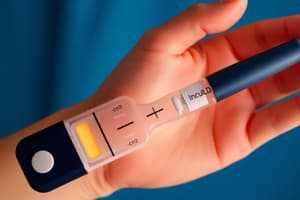Podcast
Questions and Answers
AJ is a 19 year-old woman who comes into your community pharmacy. She would like to get Ensure or another high-calorie nutritional supplements. You sense something may be off and after some questioning, she tells you that she loses weight despite eating a lot, and has difficulty exercising because she feels fatigued and her performance decreases. You noticed that she had fruity breath. She also states that she tries not to go out much especially to places where there are no restrooms available. Based on the symptoms presented, which disease state does the 19-year-old patient most likely suffer from?
AJ is a 19 year-old woman who comes into your community pharmacy. She would like to get Ensure or another high-calorie nutritional supplements. You sense something may be off and after some questioning, she tells you that she loses weight despite eating a lot, and has difficulty exercising because she feels fatigued and her performance decreases. You noticed that she had fruity breath. She also states that she tries not to go out much especially to places where there are no restrooms available. Based on the symptoms presented, which disease state does the 19-year-old patient most likely suffer from?
- Diabetes Insipidus
- Type 2 Diabetes Mellitus
- Type 1 Diabetes Mellitus (correct)
- Hypothyroidism
AJ is a 19 year-old woman who comes into your community pharmacy. She would like to get Ensure or another high-calorie nutritional supplements. You sense something may be off and after some questioning, she tells you that she loses weight despite eating a lot, and has difficulty exercising because she feels fatigued and her performance decreases. You noticed that she had fruity breath. She also states that she tries not to go out much especially to places where there are no restrooms available. Considering the patient's likely condition, which statement about her disease is most likely true?
AJ is a 19 year-old woman who comes into your community pharmacy. She would like to get Ensure or another high-calorie nutritional supplements. You sense something may be off and after some questioning, she tells you that she loses weight despite eating a lot, and has difficulty exercising because she feels fatigued and her performance decreases. You noticed that she had fruity breath. She also states that she tries not to go out much especially to places where there are no restrooms available. Considering the patient's likely condition, which statement about her disease is most likely true?
- Her alpha-cells in the Islets of Langerhans are not functioning properly.
- The cause of her disease is likely an autoimmune disorder. (correct)
- She is showing signs of insulin resistance.
- She has a surplus of insulin.
What is a characteristic of ketoacidosis that a pharmacist should explain to a patient with type 1 diabetes?
What is a characteristic of ketoacidosis that a pharmacist should explain to a patient with type 1 diabetes?
- There is formation of ketone bodies. (correct)
- It is seen mostly in patients with type 2 diabetes.
- There is inhibition of lipolysis in the liver. (correct)
- It can cause metabolic alkalosis.
A patient with type 1 diabetes begins exercising regularly after starting insulin therapy. If she presents with symptoms of paleness, tachycardia, and sweating, what is she most likely experiencing?
A patient with type 1 diabetes begins exercising regularly after starting insulin therapy. If she presents with symptoms of paleness, tachycardia, and sweating, what is she most likely experiencing?
Why does the patient experience fruity breath?
Why does the patient experience fruity breath?
What is the most likely reason for the patient’s fatigue and decreased exercise performance?
What is the most likely reason for the patient’s fatigue and decreased exercise performance?
Why is it imperative to warn patients about the possible consequences of not adhering to their insulin regimen?
Why is it imperative to warn patients about the possible consequences of not adhering to their insulin regimen?
Which of the following is the most important counseling point for a newly diagnosed type 1 diabetic who wants to start exercising?
Which of the following is the most important counseling point for a newly diagnosed type 1 diabetic who wants to start exercising?
Besides cramping and muscle weakness, which additional symptoms would suggest hypocalcemia?
Besides cramping and muscle weakness, which additional symptoms would suggest hypocalcemia?
What is the most likely underlying pathogenesis of osteoporosis in the patient's mother?
What is the most likely underlying pathogenesis of osteoporosis in the patient's mother?
How does the luteinizing hormone (LH) surge primarily induce ovulation?
How does the luteinizing hormone (LH) surge primarily induce ovulation?
Where is testosterone (T) produced, considering its initial precursor?
Where is testosterone (T) produced, considering its initial precursor?
Which statement accurately describes hormone production in theca and granulosa cells?
Which statement accurately describes hormone production in theca and granulosa cells?
Which hormone or protein is essential for supporting spermatogenesis?
Which hormone or protein is essential for supporting spermatogenesis?
Given the thyroid function tests (TFTs) showing high TSH and low T4 and T3 levels, what is the most appropriate diagnosis?
Given the thyroid function tests (TFTs) showing high TSH and low T4 and T3 levels, what is the most appropriate diagnosis?
Which of the following thyroid hormones is the most physiologically active?
Which of the following thyroid hormones is the most physiologically active?
Which of the following characteristics is typically associated with Type 1 Diabetes Mellitus?
Which of the following characteristics is typically associated with Type 1 Diabetes Mellitus?
Which hormone function pair is incorrect concerning glucose regulation?
Which hormone function pair is incorrect concerning glucose regulation?
Considering the initial precursor molecule, where is testosterone (T) primarily synthesized in males?
Considering the initial precursor molecule, where is testosterone (T) primarily synthesized in males?
Concerning hormone production within ovarian cells, which statement accurately describes the interplay between theca and granulosa cells during follicle maturation?
Concerning hormone production within ovarian cells, which statement accurately describes the interplay between theca and granulosa cells during follicle maturation?
Which hormone or protein is indispensable for sustaining spermatogenesis within the seminiferous tubules?
Which hormone or protein is indispensable for sustaining spermatogenesis within the seminiferous tubules?
Considering AJ's symptoms of weight loss despite increased appetite, fatigue, fruity breath, and frequent restroom visits, which underlying metabolic disturbance is most likely contributing to her condition?
Considering AJ's symptoms of weight loss despite increased appetite, fatigue, fruity breath, and frequent restroom visits, which underlying metabolic disturbance is most likely contributing to her condition?
Given thyroid function tests (TFTs) indicating high TSH and low T4 and T3 levels, what is the most appropriate diagnosis regarding thyroid dysfunction?
Given thyroid function tests (TFTs) indicating high TSH and low T4 and T3 levels, what is the most appropriate diagnosis regarding thyroid dysfunction?
Given AJ's diagnosis of type 1 diabetes, which statement regarding the pathophysiology of her condition is most accurate?
Given AJ's diagnosis of type 1 diabetes, which statement regarding the pathophysiology of her condition is most accurate?
Which of the following best describes the significance of ketone body formation in the context of ketoacidosis?
Which of the following best describes the significance of ketone body formation in the context of ketoacidosis?
Which characteristic distinguishes Type 1 Diabetes Mellitus from Type 2?
Which characteristic distinguishes Type 1 Diabetes Mellitus from Type 2?
In a Type 1 diabetic patient on insulin, what is the combined effect of muscle and liver response to insulin?
In a Type 1 diabetic patient on insulin, what is the combined effect of muscle and liver response to insulin?
Upon starting an exercise regimen alongside insulin therapy, a type 1 diabetic patient experiences paleness, tachycardia, and sweating. What is the most likely physiological explanation for these symptoms?
Upon starting an exercise regimen alongside insulin therapy, a type 1 diabetic patient experiences paleness, tachycardia, and sweating. What is the most likely physiological explanation for these symptoms?
In a patient with type 1 diabetes, what is the primary mechanism by which a lack of insulin leads to decreased exercise performance and persistent fatigue?
In a patient with type 1 diabetes, what is the primary mechanism by which a lack of insulin leads to decreased exercise performance and persistent fatigue?
Why is patient education regarding the consequences of insulin non-adherence particularly crucial in type 1 diabetes management?
Why is patient education regarding the consequences of insulin non-adherence particularly crucial in type 1 diabetes management?
A 70-year-old woman experiences muscle weakness and cramping. Besides these symptoms, which additional signs or symptoms would most strongly suggest the presence of hypocalcemia?
A 70-year-old woman experiences muscle weakness and cramping. Besides these symptoms, which additional signs or symptoms would most strongly suggest the presence of hypocalcemia?
Flashcards
Type 1 Diabetes Mellitus
Type 1 Diabetes Mellitus
An autoimmune disease where the pancreas produces little to no insulin.
Symptoms of Type 1 Diabetes
Symptoms of Type 1 Diabetes
Symptoms include weight loss, fatigue, frequent urination, and fruity breath.
Ketoacidosis
Ketoacidosis
A serious complication of diabetes where the body produces excess ketones leading to acidosis.
Insulin Resistance
Insulin Resistance
Signup and view all the flashcards
Signs of Hypoglycemia
Signs of Hypoglycemia
Signup and view all the flashcards
Islets of Langerhans
Islets of Langerhans
Signup and view all the flashcards
Autoimmune Disorder
Autoimmune Disorder
Signup and view all the flashcards
Exercise and Blood Sugar
Exercise and Blood Sugar
Signup and view all the flashcards
Prevention of Osteoporosis
Prevention of Osteoporosis
Signup and view all the flashcards
Symptoms of Hypocalcemia
Symptoms of Hypocalcemia
Signup and view all the flashcards
Cause of Osteoporosis in Mother
Cause of Osteoporosis in Mother
Signup and view all the flashcards
LH Surge Function
LH Surge Function
Signup and view all the flashcards
Follicle Composition
Follicle Composition
Signup and view all the flashcards
Active Thyroid Hormones
Active Thyroid Hormones
Signup and view all the flashcards
Cells that Build Bone
Cells that Build Bone
Signup and view all the flashcards
Insulin Function in Liver
Insulin Function in Liver
Signup and view all the flashcards
Type 1 Diabetes Characteristics
Type 1 Diabetes Characteristics
Signup and view all the flashcards
Hypothyroidism Diagnosis
Hypothyroidism Diagnosis
Signup and view all the flashcards
Type 1 Diabetes Symptoms
Type 1 Diabetes Symptoms
Signup and view all the flashcards
Cause of Type 1 Diabetes
Cause of Type 1 Diabetes
Signup and view all the flashcards
Diabetic Ketoacidosis
Diabetic Ketoacidosis
Signup and view all the flashcards
Effects of Hypoglycemia
Effects of Hypoglycemia
Signup and view all the flashcards
Insulin and Exercise
Insulin and Exercise
Signup and view all the flashcards
Hyperglycemia Symptoms
Hyperglycemia Symptoms
Signup and view all the flashcards
Calcium Intake Importance
Calcium Intake Importance
Signup and view all the flashcards
Vitamin D Role
Vitamin D Role
Signup and view all the flashcards
Pathogenesis of Osteoporosis
Pathogenesis of Osteoporosis
Signup and view all the flashcards
Function of LH Surge
Function of LH Surge
Signup and view all the flashcards
Inhibitory Role of Inhibin
Inhibitory Role of Inhibin
Signup and view all the flashcards
Role of Testosterone in Spermatogenesis
Role of Testosterone in Spermatogenesis
Signup and view all the flashcards
Granulosa Cells Role
Granulosa Cells Role
Signup and view all the flashcards
Character of Type 1 Diabetes
Character of Type 1 Diabetes
Signup and view all the flashcards
Physiologically Active Thyroid Hormones
Physiologically Active Thyroid Hormones
Signup and view all the flashcards
Osteoblasts Function
Osteoblasts Function
Signup and view all the flashcards
Insulin's Effect in the Liver
Insulin's Effect in the Liver
Signup and view all the flashcards
Study Notes
Type 1 Diabetes Mellitus
- Age: Young (19 years old) is a risk factor
- Symptoms: Frequent urination, excessive eating despite weight loss, fatigue, decreased exercise performance, fruity breath (ketoacidosis), increased thirst.
- Pathophysiology: Autoimmune disorder where the body attacks and destroys the insulin-producing beta cells in the pancreas
- Complication: Hyperglycemia can lead to ketoacidosis and even coma
- Characteristics: Gradual onset is not a characteristic, presence of autoantibodies is a characteristic and is often associated with this disorder.
- Important Note: This condition is often associated with weight loss despite increased food intake and the fruity breath is a result of accumulation of ketones.
Ketoacidosis
- Cause: Accumulation of ketone bodies due to insufficient insulin leading to high blood sugars.
- Effect: Metabolic acidosis (a dangerous drop in blood pH)
- Association with Type 1 Diabetes: More common in type 1, although it can occur in type 2.
- Management: Requires immediate medical attention and insulin administration
Hypoglycemia
- Cause: Excess insulin or insufficient food intake leading to lower than normal blood glucose levels
- Symptoms: Pale skin, tachycardia (fast heartbeat), sweating, tremors, and confusion.
Osteoporosis Prevention in Elderly Patient
- Calcium Intake: Increase calcium intake (milk, fortified foods)
- Vitamin D Supplementation: Consider vitamin D supplementation depending on blood levels. Vit D is important for calcium absorption.
- Bisphosphonates: Prescription bisphosphonates is not necessarily recommended without a prior diagnosis of osteoporosis. It is crucial to first determine if the bone loss warrants such treatment.
- Fall Prevention: Important to reduce the risk of falls, such as improving home safety, vision checks and balance training
Hypocalcemia Symptoms
- Symptoms: Muscle cramps, weakness, fatigue, stridor (a high-pitched breathing sound), spasms, seizures, arrhythmias (irregular heart beats), tetany (muscle spasms), and convulsions.
Pathogenesis of Osteoporosis
- Accelerated bone resorption: Bone breakdown occurs faster than bone building. More bone breakdown than building.
- Decreased bone formation: Bone building is slower than bone breakdown. Fewer cells building bone.
Ovulation and the LH Surge
- Mechanism: The LH surge, triggered by high estrogen levels via a positive feedback loop, stimulates ovulation by releasing the mature egg from the dominant follicle.
Hormone Production
- Testosterone Production: Occurs in Leydig cells in the testes from cholesterol.
- Testosterone to Dihydrotestosterone: Conversion happens with 5-alpha reductase. Testosterone is converted to dihydrotestosterone (DHT).
Follicle Structure
- Components: Follicles are made up of granulosa cells, theca cells, and an ovum (egg).
- Location: Located in the ovaries.
- Endometrium: Endometrium is the uterine lining, crucial during the menstrual cycle.
Spermatogenesis Support
- Testosterone (T): Essential for sperm maturation.
- Inhibin: Regulates FSH and LH (negative feedback).
- ABP: Androgen-binding protein increases T availability in the seminiferous tubules.
- FSH: Acts on Sertoli cells to produce nutrients for developing sperm.
Hypothyroidism Diagnosis
- High TSH, low T3 and T4: Indicates primary hypothyroidism. This means the thyroid gland is not producing enough thyroid hormone.
Thyroid Hormones
- Active Hormones: T3 is the most active thyroid hormone. T4 is an inactive hormone and needs to be converted into T3 in the body.
Bone Formation
- Cells: Osteoblasts are the bone-building cells.
Type 1 Diabetes Characteristics
- Gradual Onset: Not a characteristic.
- HHS (Hyperglycemic Hyperosmolar State) and Obesity: Not characteristics of Type 1, these are seen in type 2.
- Autoantibodies: Present in type 1.
Insulin Functions in the Liver
- Glucose Uptake: Insulin increases glucose uptake by the liver for glycogen synthesis (storage).
Hormone Function Pairs
- Insulin/Glucose and Lipid Storage: Correct.
- Glucagon/Increased Glucose Production: Correct.
- Epinephrine/Increase Glucose Production: Correct.
- Amylin/Inhibit Glucose Production: Correct. Amylin inhibits glucagon (a hormone that raises blood sugar), decreasing glucose release from the liver.
Studying That Suits You
Use AI to generate personalized quizzes and flashcards to suit your learning preferences.




